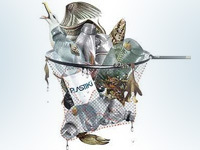Drowning in plastic
 By Richard Grant, Telegraph.comGLOBE-Net - Way out in the Pacific Ocean, in an area once known as the doldrums, an enormous, accidental monument to modern society has formed. Invisible to satellites, poorly understood by scientists and perhaps twice the size of France, the Great Pacific Garbage Patch is not a solid mass, as is sometimes imagined, but a kind of marine soup whose main ingredient is floating plastic debris.
By Richard Grant, Telegraph.comGLOBE-Net - Way out in the Pacific Ocean, in an area once known as the doldrums, an enormous, accidental monument to modern society has formed. Invisible to satellites, poorly understood by scientists and perhaps twice the size of France, the Great Pacific Garbage Patch is not a solid mass, as is sometimes imagined, but a kind of marine soup whose main ingredient is floating plastic debris. It was discovered in 1997 by a Californian sailor, surfer, volunteer environmentalist and early-retired furniture restorer named Charles Moore, who was heading home with his crew from a sailing race in Hawaii, at the helm of a 50ft catamaran that he had built himself.
There are now 46,000 pieces of plastic per square kilometre of the world’s oceans, killing a million seabirds and 100,000 marine mammals each year. Worse still, there seems to be nothing we can do to clean it up. So how do we turn the tide?
For the hell of it, he decided to turn on the engine and take a shortcut across the edge of the North Pacific Subtropical Gyre, a region that seafarers have long avoided. It is a perennial high pressure zone, an immense slowly spiralling vortex of warm equatorial air that pulls in winds and turns them gently until they expire.
Several major sea currents also converge in the gyre and bring with them most of the flotsam from the Pacific coasts of Southeast Asia, North America, Canada and Mexico. Fifty years ago nearly all that flotsam was biodegradable. These days it is 90 per cent plastic.
See also article “A Sea of Garbage”
For More Information: Telegraph.com
You can return to the main Market News page, or press the Back button on your browser.

